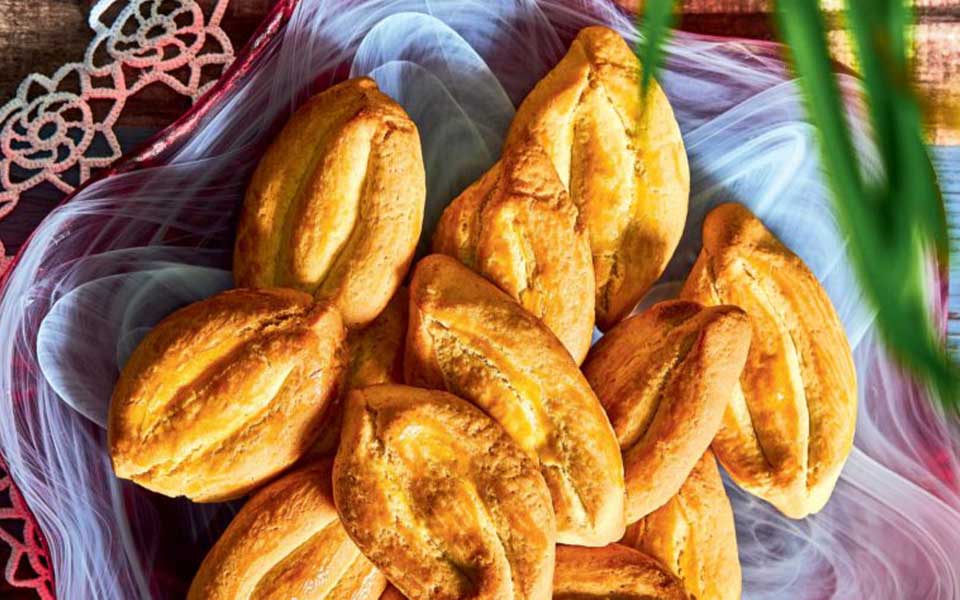Smyrna cookies, along with tsoureki and red eggs, are now an essential component of many households’ culinary traditions. We refer to them as Smyrna cookies because they originated in Asia Minor. In Smyrna, they are called Easter cookies because they are traditionally associated with Easter. In Greece, however, they were referred to as Smyrna cookies because they became widely known after 1922, when refugees from Asia Minor brought with them the recipes of their homeland. According to Aikaterini Polymerou-Kamilaki, former director and scientific collaborator of the Hellenic Folklore Research Centre of the Academy of Athens, sweet and fluffy breads, such as cakes, were virtually unknown in Greece. The same is true for sugar, a luxury item that was rarely used in Greek confectionery, except as a sweetener in beverages, and was only available to the privileged social classes. The most common sweeteners were honey and grape molasses.
However, sugar was a popular ingredient in cosmopolitan Smyrna, where it was imported from Europe via Constantinople. “Recipes on how to make cakes, sponge cakes, meringues, and sweet breads also arrived from Europe together with sugar, allowing the women of Asia Minor to perfect recipes such as vasilopita (which in Smyrna was a sweet cake with dried fruits, nuts, and spices), tsoureki, and of course cookies and koulourakia,” explains Mrs. Polymerou-Kamilaki.
One starts to appreciate the variety, finesse, and uniqueness of their sweets when one considers the abundance of spices they also had at their disposal, such as cardamom, vanilla, mahleb, mastic from the island of Chios, and so many other “strange” ingredients. Privileged and daring, the women of Smyrna created a baking tradition that was entirely different from that of Greece.
Smyrna means exotic
These kinds of desserts were unknown to the Greeks. Greek vasilopita, for instance, was traditionally a savoury filo pastry pie filled with meat, poultry, and/or vegetables. Similarly, Christopsomo was made without sugar or spices and instead sweetened with a small amount of honey or grape molasses “to sweeten the new year.” Tsoureki was unknown. In other words, people were unfamiliar with sweet, fluffy, baked goods, except in major cities. As soon as tsoureki, sponge cakes, cakes (some even with chocolate and cocoa!), and fluffy koulourakia scented with butter and mastic were introduced, they were embraced, loved and adopted immediately. The term smyrneika (“from Smyrna”) was applied to everything the women of Smyrna brought with them, which is how these cookies got their name.
Smyrna cookies are made primarily with high-quality butter and aromatic spices such as vanilla, but orange zest or mastic are also used. Despite the numerous variations, they are all distinguished by their fluffy yet crispy texture, aroma, and finesse. The most common shapes are an elongated spiral (like a small boat), a snail, and a double snail, but they are frequently braided into a simple braid as well.
Instructions
To make Smyrna cookies, place the cold butter in a mixing bowl and beat with the paddle attachment until it forms a smooth white cream. If you don’t have a mixer, bring it to room temperature and pour it into a bowl.
Add the sugar and beat (or mix thoroughly by hand) until dissolved.
Add the egg yolks one at a time, mixing thoroughly after each, and then add the vanilla extract.
Pour in the cognac and orange juice and mix for about half a minute.
In a separate bowl, combine 100g of the flour with the baking powder and add to the mixture.
Add 1kg of flour and knead until it is fully incorporated into the dough. If the dough is too sticky, gradually add the remaining flour, kneading thoroughly after each addition; you may not need all of it.
The dough should be soft, elastic, and slightly sticky. Try shaping one and see if more flour is needed. Keep in mind that shaping requires some experience and practice; this dough tends to shrink almost immediately, so the cookies must be shaped quickly.
Preheat the oven to 180°C.
Line the baking sheets with parchment paper (since we are making many cookies, we will need to bake them in batches, so you will need at least three baking sheets).
Cut the dough into pieces weighing 30 grams each, shape them into thin cords and twist them into an s-shape, making sure the ends touch. Lightly press the edges to make them more pointed. This way, the cookies will look like little boats. Alternatively, we can shape them into rings or small braids.
Arrange the cookies on the baking sheets, leaving some space between them because they will expand slightly while baking.
Brush well with the beaten egg yolks and bake.
Bake for about 25-30 minutes, until golden.
Originally published in Gastronomos magazine.
Ingredients
- 500g sheep & goat butter, from a jar, cold
- 500g (2½ cups) sugar
- 2 egg yolks
- 2 caps of vanillin
- 110ml (1 wine glass) high-quality cognac
- 280ml (1 water glass) freshly squeezed orange juice
- about 1,500g (1-1½ cups) all-purpose flour
- 20g (1 sachet) baking powder
For brushing
- 8-10 egg yolks, beaten well with a fork (enough to make the koulourakia shine properly)














